A CLIMB UP DUNETHIN ROCK TO WATCH THE SUN SET....
After wandering through the MaroochyWetlands, we decided to drive a little further until we got to Dunethin Rock Road. Our plan was to check out Dunethin Rock and climb it to watch the sun set.
Dunethin
Rock has been a landmark tourist destination for over a century offering
peaceful views over the Maroochy River, it’s mangroved banks, cane fields and
Mount Coolum and Mount Ninderry to the north.
Meaning place of swimming trees, its name reflects the region’s timber-logging
past. In the 1860s, logs were rafted down the Maroochy river to this point,
where they were loaded onto boats bound for Brisbane sawmills. Today, the rock
is still appreciated for the vistas from the summit and is part of the Maroochy
River paddler’s trail.
We missed the parking bay for the climb up onto Dunethin Rock and ended up at the River Bank...
As you drive into the reserve
there is a wharf which goes out over Dunethin Lake. You then come to a nice
picnic area with a shelter shed alongside the river. A little further down the
road there is a launching ramp. From the picnic area drive up the hill and you will see the big monolith
Dunethin Rock. There is another shelter shed with picnic tables alongside.
The views from the rock are spectacular allowing you to see sweeping views from
the Blackall Range to the coast. the view is great over the lush vegetation,
sugar cane fields and farmlands along the edge of the winding course of the
Maroochy River.
 |
| Mount Ninderry... |
What a pleasant surprise this area is. We had not heard of it before but it was quite popular with a few families down there fishing and a group of young youths casting a line or two as well. We drove along the river bank until we came to a boat launching ramp.. The views even from the river here were lovely. with Mount Ninderry and the cane fields in the foreground...
The kids were pretty keen to hop out of the car and explore the river bank hopping over the rocks, Max found a bit stick which then had him using his imagination as he fished the river and caught the biggest fish. So precious...
 |
| His pretend fishing rod... |
 |
| He caught a big one.... |
We headed back along the river heading in the opposite direction where we came across a man walking his dog and stopped to ask him directions. He told us that we needed to head back up the hill until we saw the small shelter shed again and we parked there to walk out onto the rock...
 |
| peaceful and serene along the river bank... |
The kids were keen to get out and scamper over the first rock they saw. We headed to the right and walked out along the top of the rock here where we had some great views out towards Mount Coolum. This was not the main rock we wanted to climb but the kids were having a great time exploring and heading further out and down the rock surface..
I was a little worried that they would get to close to the edge but Steve assured me that there were not edges and that they rock sloped down towards the ground below...
 |
| Some massive homes built on the riverbank |
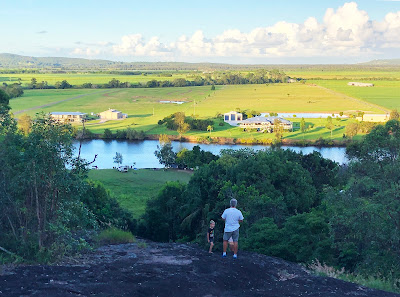 |
| Stunning stunning view.. |
Max in particular loved climbing on the rock.. It is so good that we can do these sorts of things with the kids and create these wonderful memories...
Max came across some itchy grubs crawling along the massive rock and was quite fascinated by them. We all got hauled over to look at them and check them out...
The rocks around here were also covered in a few different varieties of lichen and mosses that we checked and mix that with the pink granite rock, added colour to the monolith...
A rough path from the road edge is shaded by a range of mature trees and
leads to a plateau at the summit, a natural viewing platform. This area of the
outcrop is bare except for the occasional rogue vegetation struggling for a
foothold and coverings of moss, lichen, dry leaves and twigs.
The rock is significant as it resembles the development of tourism during the early 1900s in the area. During this time, the mountain destinations and seaside resorts began to gain popularity. Tourist publications began to feature the beautiful waterfalls, rainforests, and rivers to explore. Today, it's a revered sight as many come from nearby to witness the majestic monolith. Aside from the rock, the panoramic views of Ninderry Range, Cooroy Mountains and Mount Coolum make the visit even more special.




Dunethin Rock was generally accessed from the river. In 1901, local residents petitioned the Lands Department to set aside the rock and its surrounds as a public reserve. The Maroochy River State School opened in 1911 on land excised from within this reserve, servicing families along the river. It operated until 1972. The Maroochy River School of Arts opened here in 1914 and served the community until 1963. Both were on the north-west of the rock and south of Dunethin Lake; the site of local aquatic sporting events. In 1923, the Moreton Central Sugar Mill at Nambour constructed a cane tramway to the rock. Tourists travelled by tramway to the river and by boat to the emerging coastal resorts. Today, the rock is appreciated for the vistas from the summit and is part of the Maroochy River paddler’s trail.
There's an Indigenous Dreamtime story
regarding Mount Ninderry, which one can view from Dunethin Lake. The
legend goes that a young Aboriginal warrior called Coolum was in love
with Maroochy, a beautiful girl from his tribe. All was well as the
tribal elders had approved their union. However, one day, a warrior
called Ninderry from another tribe kidnapped Maroochy while Coolum was
out hunting.
The two warriors engaged in an epic battle for Maroochy, and while
fighting, Ninderry struck Coolum with a club, knocking his head right
off. Coolum's headless body turned to stone, forming what is now known
as Mount Coolum and his head rolled into the sea and became Mudjimba Island.
The spirit gods were so angry by Ninderry's interference in the
approved union of Coolum and Maroochy and the killing of Coolum, that
they turned Ninderry to stone and he became Mount Ninderry.
When Maroochy discovered what had happened to her beloved Coolum, she
fled inland to the Blackall Ranges, where she wept so much her tears
flooded down the mountain range to the sea, forming the Maroochy River.
Maroochy was determined to find Coolum's spirit, so she transformed
herself into a swan so she could travel up and down the river in search
of her lover's spirit.
 |
| Stunning sunset... |
And just like that, it was the end of another beautiful day... it is so important to live life and enjoy every second in this life that we are given. It's good to appreciate all that we have as many don't get the chance to even live to the age we are at...
We have so enjoyed out visit to Dunethin Rock. It is a stunning, somewhat 'hidden' spot, where one can fish, picnic or enjoy a paddle. For the more adventurous, it is worth the climb up to top of Dunethin Rock - it's all part and parcel of this well-kept secret.


















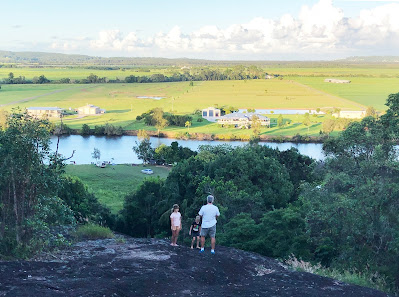





































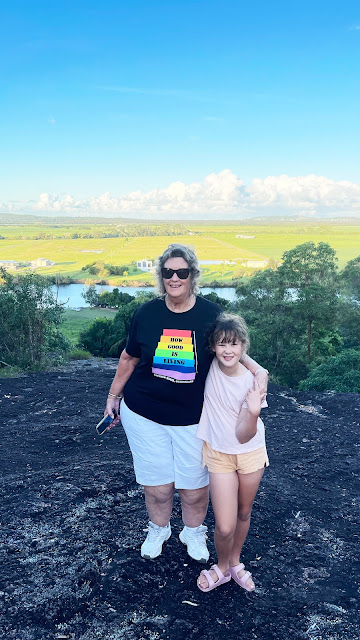































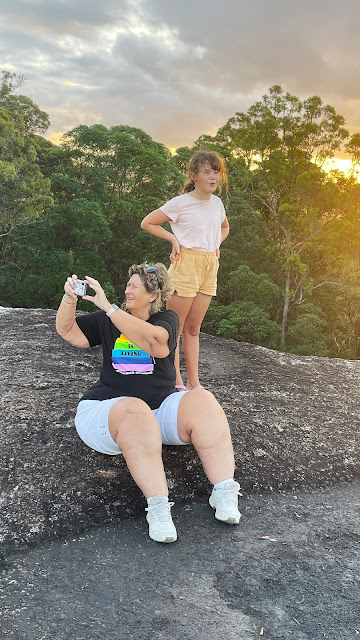
















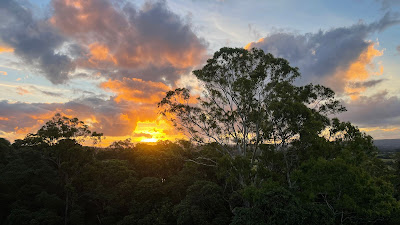







0 comments:
Post a Comment